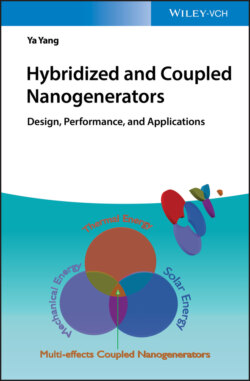Читать книгу Hybridized and Coupled Nanogenerators - Ya Yang - Страница 43
2.3.4.4 Self‐Powered Wearable Electronics
ОглавлениеTogether with the advancement of digital health, wearable electronics are attracting extensive attention. Currently, powering these electronic devices mainly depends on rechargeable batteries, limiting their further applications. To effectively extend the lifetime of the wearable electronics, a number of different research teams have begun to develop new technologies for harvesting energy from our living environment.
Figure 2.15 The self‐powered wind vector sensor system. (a) Photograph of the four TENGs orientation. (b) Schematic diagram of the circuit. (c) Measured output current. (d) Measured output voltage. (e–h) Measured output voltage mapping figures for different wind directions.
Source: Reproduced with permission from Yang et al. [32]. Copyright 2013, American Chemical Society.
Figure 2.16 The polarization system. (a) Schematic illustration of the working principle of the polarization system. (b) Photograph of the handheld TENG‐based polarization device. (c) Measured piezoelectric coefficient for different polarization times. (d) Photograph of the effective polarization result.
Source: Reproduced with permission from Liu et al. [75]. Copyright 2018, Elsevier.
Jiang et al. fabricated a smart WD‐TENG, which can be used to power some wearable electronics by harvesting various human motorial energies [67–69]. By dexterous designs, the TENGs can be used as self‐powered devices to monitor different human movements. Figure 2.17a shows that the TENG can be integrated into a shoe. The human motion state under the feet could be realized by measuring the output voltages under different leg movements, which respectively correspond to walking, jogging, and running. In addition, the electric energy generated by the device can power three light‐emitting diodes, as shown in Figure 2.17b. On the other hand, the wind‐driven TENG can also be processed into a self‐powered bracelet device. The mechanical energy of arm swing could be transformed to electric energy by the TENG. By measuring the output voltages, different arm movements can be monitored. Wang et al. fabricated a self‐powered healthcare monitoring device based on wind‐driven TENG [34]. This device can monitor human nose breath, as shown in Figure 2.18a. Figure 2.18b shows that the TENG can convert the flow from human breath to electrical energy, achieving an output voltage peak of about 30 V. By the up‐flow chip, the output current of the TENG can be increased to about 350 μA, as shown in Figure 2.18c. The electrical energy generated by the TENG can be used to charge a capacitor, as illustrated in Figure 2.18d. Figure 2.18e,f shows that the temperature sensor can be powered by harvesting human nose blown air flow via the TENG.
Figure 2.17 Wind‐driven wearable electronics. (a) TENG‐based shoe for monitoring leg movements.
Source: Reproduced with permission from Jiang et al. [67]. Copyright 2018, American Chemical Society.
(b) The electrical energy form the device can power LEDs. (c) The wind‐driven TENG‐based band for monitoring hand movements.
Source: Reproduced with permission from Jiang et al. [69]. Copyright 2017, American Chemical Society.
